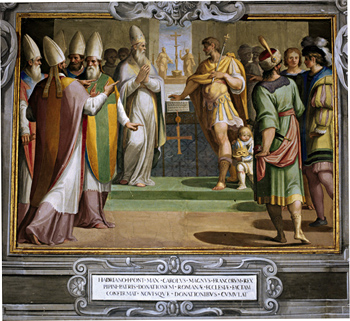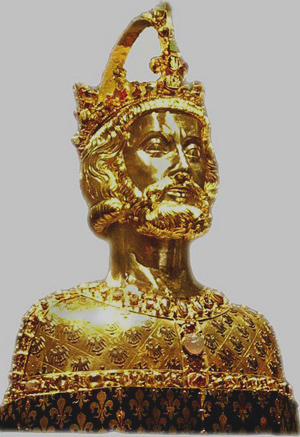 |
World History
The Carolingian Donations to
the Papal States
William Oncken
Charlemagne spent Christmas of 773 in the Pavia encampment, and, as Easter approached, his desire grew to go to Rome to pray in the Sanctuary of the Apostles for reasons of devotion, although certainly political motives also were not absent. His father, Pepin the Short, no less devout than the son, twice had made the siege of Pavia with him, but had not travelled to Rome, despite the short distance. The son had certainly decided to incorporate the Lombard Kingdom to his Empire, and for this, he would need the agreement of the Pope, with whom he would confirm the Donation of Pepin, in addition to making others. (1)

Charlemagne meeting with Adran I to confirm and increase the donations to the Pope |
At the end of March, Charlemagne, accompanied by a large entourage of Bishops, Abbots, Dukes, Counts and men of arms, undertook the trip to Rome, while the siege of Pavia continued. He passed through Tuscany, and at Novae (situated 30 Roman miles from the Eternal City) he was met by companies of armed men called scholae militiae and students bearing palms and olive branches who had been sent by the Pope. They also carried crosses and sang hymns, at times making special acclamations, calling him Exarch of Ravenna and Patrician [a Roman noble], the titles granted to Charlemagne since 754.
Upon meeting the students and crosses, Charlemagne dismounted and walked on foot along with his dignitaries to the Church of St. Peter, where he was received by the Pope, who stood with his clergy at the top of the stairs.
Charles ascended the stairs, kissing each step – and there were many – until he reached the last. There they embraced, and then the King and Pope descended with their respective entourages to the Confession of St. Peter, (2) where the King asked permission to enter the city and pray in various churches.
Before the Tomb of St. Peter, they both swore to abide by what had been agreed upon, and the King entered the city, where he assisted at three baptisms carried out by the Pope in the Basilica of the Savior (next to the Lateran). It was April 2, Holy Saturday of 774. Then the King returned to St. Peter’s. The next day, Easter Sunday, friars and men of arms came out to meet him and accompany him to the Church of Santa Maria [St. Mary Major] where he assisted at Mass and afterward dined with the Pope. The next two days he heard Masses in the Churches of St. Paul and St. Peter. The Pope also presented Charlemagne with a collection of Canons, accompanied by gracious words.

A bust of the Emperor Charlemagne |
On April 6, there was a grand political meeting in the Church of St. Peter. At it, the Pope requested the full recognition and confirmation of the territories offered to the Roman Pontiff by Pepin, by King Charles himself and by Carloman. (3) Then the letter dated April 14, 774 in Quierzy and entitled Per donationis paginam was read aloud. The content of such document was acknowledged and confirmed by the King in a new letter, written by the chaplain Hiterius. In it the King granted and offered to deliver to the Holy See a large number of cities and territories (which despite the ups and downs of History, in large part effectively passed to the power of the Pope.)
They were Iuni, including the island of Corsica, Sarzano, Mount Bardonis, the valley of the Apennines, La Cisa (between Parma and Contremoli), Barceto, Parma, Reggio, and from Modena to Monte Silicis; this is addition to the whole of Exarchate of Ravenna following its old borders, the provinces of Venice and Istria, and the entire Dukedoms of Spoleto and Benevento.
All the Bishops, Dukes and Counts signed this act, which was then placed over the altar, and afterward taken to the Confession. There, the King and his Franks swore to execute the Donation, and the King placed a copy scripted by Hiterius over the Gospels, next to the body of St. Peter. Finally, he took with him copies of those documents kept in the scrinarius [safe for important documents] of the Holy See.
1. Pepin the Short, father of Charlemagne was anointed as King of the Franks by St. Boniface in 751. He obliged the Lombards to return property seized from the Church and gave the papacy the Exarchate of Ravenna and Pentapolis. This was the Donation of Pepin, which founded the Papal States. Charlemagne’s desire to visit Rome, mentioned above, was to meet with the recently elected Pope Adrian I.
2. The Chapel of the Confession was the underground crypt where the bones of St. Peter were venerated. The word 'Confession' refers to the Confession of faith by St. Peter which led to his martyrdom.
3. Carloman and Charlemagne were sons of Pepin the Short; at the death of Pepin his kingdom was divided into two parts, one for each brother. Carloman reigned over his part until his death in 771; thenceforward Charlemagne reigned alone.

W. Oncken, História Universal,
Barcelona: Montaner y Simón, vol. XII, pp. 357-358
Posted December 24, 2008

Related Topics of Interest
 The Personality of Charlemagne The Personality of Charlemagne
 Hernan Perez del Pulgar of the Valiant Deeds Hernan Perez del Pulgar of the Valiant Deeds
 Prayer to Charlemagne Prayer to Charlemagne
 The Moral Education of the Knight The Moral Education of the Knight
 The Investiture of a Knight The Investiture of a Knight
 The Organic Formation of Feudalism The Organic Formation of Feudalism
 The Dream of Empire The Dream of Empire
 The Coronation Feast for an Emperor The Coronation Feast for an Emperor

Related Works of Interest
|
|
History | Home | Books | CDs | Search | Contact Us | Donate

© 2002- Tradition in Action, Inc. All Rights Reserved
|
 |
|